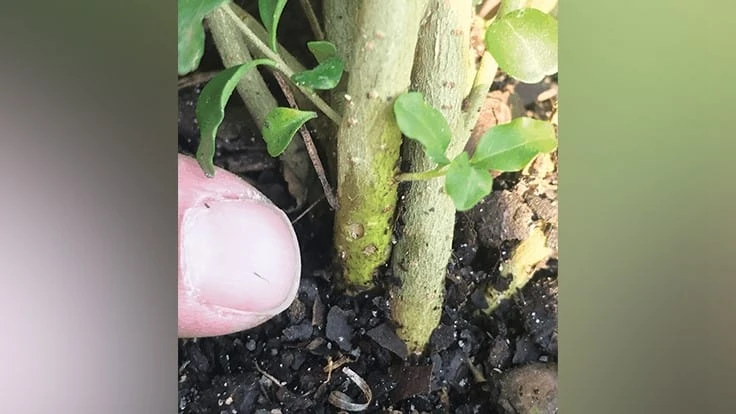

Although less common than traditional ornamental insect pests like whiteflies and thrips, the European pepper moth and red-headed flea beetle are two pests continuing to gain notoriety across the country. While both pests have their signature activity, they share one thing in common: plant damage. J.C. Chong, professor of entomology at Clemson University and Nancy Rechcigl, technical services manager of ornamentals at Syngenta, share ways growers can control, combat and contain these pests.
While the European pepper moth originated in Europe, Rechcigl says their appearance in the U.S. has grown over the last five years. In 2014, the moth was a confined “quarantine pest” in a small area in Southern California, but now, she says they are being seen in states in the Northeast like New Jersey, New York, Connecticut and Pennsylvania, along with Southeastern states including Florida and in Texas. Chong says he’s also seen “a big jump” of moths in North and South Carolina.
Rechcigl recalls the first observance of European pepper moths in herbaceous crops, annuals, perennials and poinsettia production, but they are quickly claiming other crops. “We are starting to see activity in woody ornamentals as well,” she says.
Chong believes the moths seek herbaceous crops and woody ornamentals because it is easier for them to feed on the plant tissue.As for the red-headed flea beetle, Rechcigl says there has also been a surge of them in outdoor ornamental production. Like the pepper moth, they feed on herbaceous and woody ornamentals, and the injury they can cause in a short period of time can leave plants unsalable, she says.
Scouting at the base of the plant is critical for finding this pest.” — NANCY RECHCIGL, technical field manager of Turf and Ornamentals at Syngenta
The damage both pests can do differ from the destruction caused by whiteflies and aphids. Instead of leaf yellowing and distortion as the result of the latter sucking pests, the pepper moths and flea beetles chew.
“The European pepper moth larvae chew and bore their way into the base of the plant,” Rechcigl says. “This can cause the plant to appear wilted and can be mistaken for a root issue. Unfortunately, if too much of the lower stem is damaged, this can result in the death of the plant. Flea beetles feed on the upper layers of leaf tissue, leaving the plant with a skeletonized appearance. The more injury present can significantly reduce the value and salability of your crop. When injury levels approach 40% or higher, the plant is often unsalable.”
Like many insect pests, scouting and preventative applications are recommended. According to Rechcigl, European pepper moths lay their eggs in the upper canopy of the plant, but after hatching, the larvae drop to the soil and begin feeding on the base.
“Scouting at the base of the plant is critical for finding this pest,” she says. “They are rather small and can almost be mistaken for fungus gnat larvae because they have a dark head capsule and are just slightly bigger in size. The larvae will produce a light webbing which provides them some protection from predators. So when scouting, look for light webbing at the base of the plant at the soil line.”
Flea beetles, however, eat the upper layers of foliage and leave the lower epidermis intact, which gives a skeletonized appearance. Rechcigl says it’s harder to scout them due to their swift movement if the foliage is disturbed, and because of this, she says the feeding injury will most likely be seen before the actual pest. Chong says the multitude of these pests make them harder to control.




“These pests are quite destructive if left unchecked, so it is important to begin control treatments as soon as indications of their presence are observed,” Rechcigl adds.
To assist growers, Syngenta offers Mainspring® GNL, Acelepryn®, Flagship® 25 WG and Scimitar® GC, insecticides that guard against many pests and provides tools for integrated pest management plans.
“For the European pepper moth, both Mainspring GNL and Acelepryn can be used to control this pest … [they] should be applied as a heavy spray over the top of the plant so the base of the plant and stem is wet at the soil line,” Rechcigl says.
Recent trials have shown Mainspring GNL and Acelepryn are effective on the European pepper moth for seven weeks.
In Chong’s 2019 trial for European pepper moths, he observed the efficacy of Mainspring GNL and Acelepryn against the pests in the greenhouse.
“From treatment until 42 days, plants that were treated with Mainspring and Acelepryn did not see any foliar damage at all,” he says. “For water-treated plants, we saw about 33% of the plants showing damage. This tells me that Acelepryn or Mainspring can wipe out the European pepper moth caterpillars.”


For flea beetles, Rechigl recommends Flagship 25 WG, Scimitar GC, Mainspring GNL or Acelepryn. During his flea beetle research, Chong sprayed plants with Acelepryn and Mainspring GNL three times at a 14-day interval.
“To give an example, at 42 days after the first treatment, 40.8% of the terminals of plants sprayed with only water suffered some level of damage,” he says. “But the damage was reduced to 21.7% and 25% for Mainspring GNL- and Acelepryn-treated plants. So, Mainspring GNL and Acelepryn can certainly reduce, but not completely eliminate foliage damage [because] there are just so many of the hungry beetles out there and damage can accumulate even if one beetle takes just a little bite.”
Trials on the flea beetles have shown three applications of Mainspring GNL and Acelepryn on a 14-day interval keeps the plant injury levels under 20% to 25% for a seven-week period.

Explore the July 2020 Issue
Check out more from this issue and find your next story to read.
Latest from Greenhouse Management
- 2025 Proven Winners Horticulture Scholarship applications now open
- How to improve inventory and shipping management in the greenhouse
- Leading Women of Horticulture: Anna Ball, Ball Hort, and Terri McEnaney, Bailey Nurseries
- GM CEA HERB Part 2: A guide to increasing the sowing density of culinary herbs
- GM CEA HERB Part 1: Best practices for producing culinary herbs in controlled environments
- USDA fires experts on invasive pests, including Asian citrus psyllid, chilli thrips
- CEA Alliance celebrates bipartisan introduction of Supporting Innovation in Agriculture Act
- Dümmen Orange North America celebrating 25th anniversary in 2025





